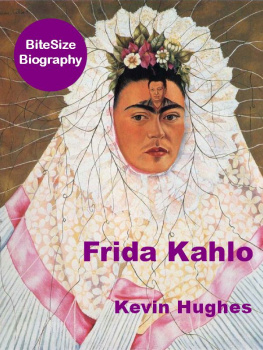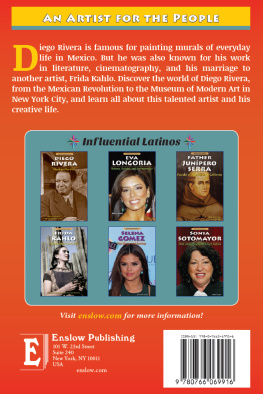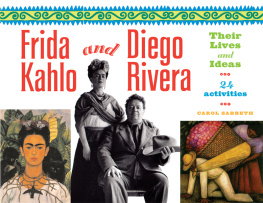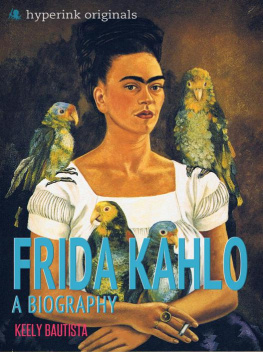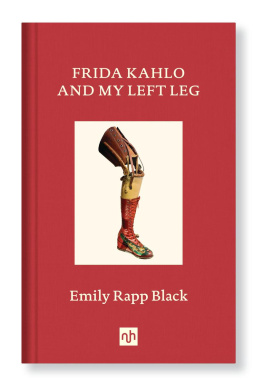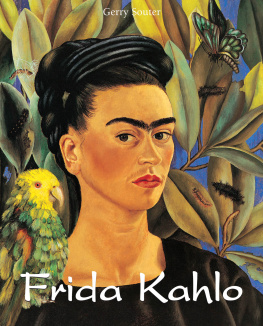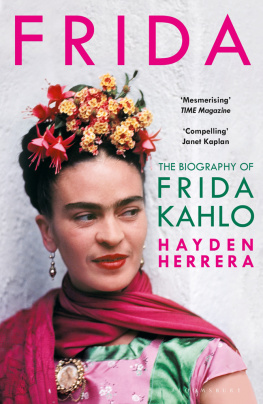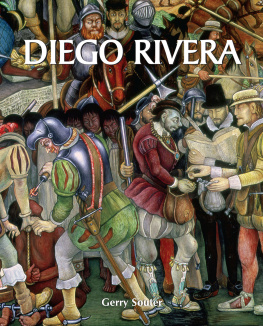Table of Contents
Frida Kahlo: The Little Dove
Kevin Hughes

Preface
Frida Kahlo is one of Mexicos most important and well-known artists. The story of her life has very much captured the imagination of a growing constituency of fans, authors, film-makers and art historians over the last thirty years.
During her lifetime she was perhaps better known as the wife of Mexicos internationally-celebrated muralist Diego Rivera; according to Fridas mother she was the dove to Diegos elephant. However, she was also respected for the quality of her own work. Her attachment to the cause of Mexican nationalism and the principles of the Mexican Revolution also ensured that she was a prominent figure in the intellectual and political life of Mexico.
In some ways, the tale of Fridas journey through physical and emotional disaster recalls the clich of the suffering artist. Perhaps this is what has drawn so many people to her work. On one level it is an accurate picture and it is certainly anyones guess whether Frida would have become such a prolific and proficient artist without the time afforded to her by the incident which rendered her virtually immobile in her late teens. However, this sort of conjecture is ultimately futile and we should merely accept that Frida Kahlo has left a legacy of some extraordinary art.
Fridas ability to convey her own pain and her aspirations for the Mexican people suggest that here is an extraordinary talent who was destined to excel as an artist. Her ability to assimilate, experiment with and, if necessary, reject different styles and ideas was also a feature of her work.
In this work I have attempted to give some background to Fridas early life. A short biography of Diego Rivera then follows. This section is necessary in order to understand the force of nature which was Rivera and from this we can see how he became such a huge influence on Fridas life.
Fridas marriage and some of her love affairs are covered in the next chapter. The story is fascinating on a human level alone, but the significance to Fridas work of events leading up to 1940 is immense. Fridas career is then examined with short descriptions of many of her paintings.
The second half of Fridas marriage to Diego is discussed in the next chapter. An increasing level of physical pain together with continued emotional stress eventually took their toll on Kahlos work. This period did also contain growing public recognition of her work until Fridas untimely death in 1954.
Her posthumous fame is the final subject to be covered. The importance placed on her work by a wide range of people since her death, and in the last thirty years in particular, is reflected upon in this chapter.
Fridas story is a fascinating and sometimes tragic one, illuminated by moments of sheer brilliance. It is also a demonstration of how an individuals will to not only survive but also to flourish is able to overcome the most painful of setbacks.
We start with the early years of Frida Kahlos life.
1. Early Years
Frida Kahlo (ne Magdalena Carmen Frieda Kahlo y Caldern) was born in Coyoacn, Mexico on July 6th 1907. Now subsumed within the urban sprawl of Mexico City, the town then lay on the outskirts of the Mexican capital. Her father, Guillermo (his given name was Wilhelm but he changed it to the Spanish version after settling in Mexico), was an migr from Germany. Guillermos father is reputed to have sent him to Mexico in1891 at the age of 18 due to the teenagers somewhat fraught relationship with his stepmother. Although there is much evidence to suggest that her father was born into a Lutheran family in the town of Pforzheim in what is now the state of Baden-Wrttemberg, Frida cultivated the myth that he was of Hungarian-Jewish stock.
Fridas mother, Matilde, was Guillermos second wife; his first wife having died in childbirth. Matilde was of mixed Spanish and native Amerindian descent; a background on which the artist drew heavily in her work despite her sometimes distant relationship with her mother.
Perhaps Kahlos artistic abilities were inherited from her father, a professional photographer and amateur artist, who worked for several Mexican publications and the Mexican government. Frida would often assist her father in retouching, colouring and developing photographs, gaining knowledge of composition and colour which would prove useful in her later career.
Frida, who was the third of the couples four daughters (she also had two half-sisters from Guillermos first marriage), contracted polio at the age of six. After extended hospitalisation she recovered, but the illness left her with extensive damage to her right leg, causing it to appear noticeably thin when compared to the left. Kahlo would disguise this disparity by wearing long, flowing dresses or trousers. The disease also left her with a permanent limp and pain that would endure for the remainder of her life. Guillermo Kahlo was determined that his daughter should recover her strength after the illness. By encouraging Frida to take part in sports and pursue an outdoor lifestyle, he hoped that the damage to her afflicted limb would be limited.
Fridas siblings and her mother occasionally accused Guillermo of favouritism towards Frida. His response was to openly declare his preference for Frida as his most intelligent daughter.
When Kahlo enrolled at the Preparatoria in Mexico City at the age of fifteen, with the intention of becoming a doctor, she was one of only 35 females out of a student body of 2000. The school enjoyed an elevated reputation throughout Mexico and Frida was a popular and lively student. It was her fathers desire that Frida enjoyed the best education possible. Her mother was initially opposed to the move, considering it unnecessary for a girl to attain academic excellence in a world where the traditional female role was still that of homemaker.
Whilst at the school, Frida was drawn to a group which included the charismatic Alejandro Gomz Arias, destined to become Fridas boyfriend. This group, known as Los Cachuchas (from the type of peaked caps that they favoured), consisted of people who would later become leading lights of the left-wing and artistic communities in Mexico. They were renowned for their propensity towards instigating pranks against fellow pupils and teachers. Fridas anti-authoritarian nature explains both the appeal of the group to her and vice versa. It must also be noted that her attraction to Alejandro also featured strongly in her desire to become part of the clique.
During Kahlos time at the school, the renowned Mexican artist, Diego Rivera, particularly famous for his murals, was commissioned to create a mural in the lecture hall. Rivera, to whom Kahlo would one day be married, became the object of her admiration, reputedly even causing her to comment that she would like to have his baby one day. However, the meeting which threw them together romantically would have to wait another few years.
The revolutionary upheavals in Mexico, which began in 1910 as a reaction to the presidency of Porfirio Diaz, were a constant backdrop to Frida Kahlos early life, with tales of the protagonists leaping into the back garden of her parents house in Coyoacn. The mythology and politics of the revolution would also have an impact on Kahlos work, particularly in later years, as well as being a key feature of her relationship with Diego Rivera. As we shall see later, Rivera was heavily involved in post-revolutionary politics.
In 1925, at the age of eighteen, Kahlo was severely injured when a bus in which she was travelling with Alejandro Gomz Arias, who by then had become her boyfriend, collided with a tram. Aside from the numerous broken bones and dislocations suffered in the crash, Kahlo was impaled on a steel handrail, which punctured her abdomen and uterus, causing severe damage to her reproductive system. The injuries sustained in the accident necessitated many months in hospital both immediately following the crash and throughout her life: she underwent over thirty operations during the course of her lifetime. The suffering that she endured as a result of the crash became an important element in her later work as an artist.

